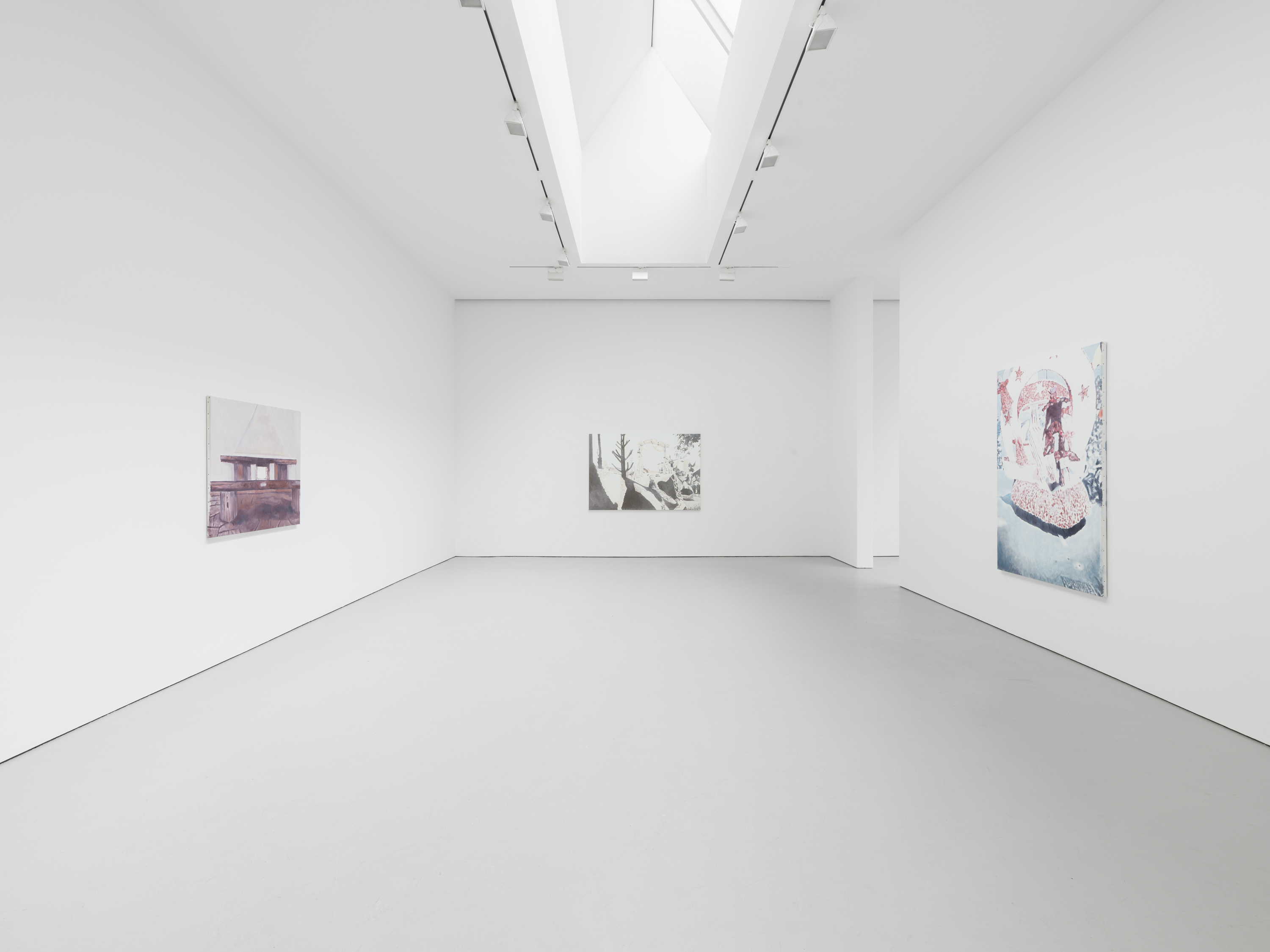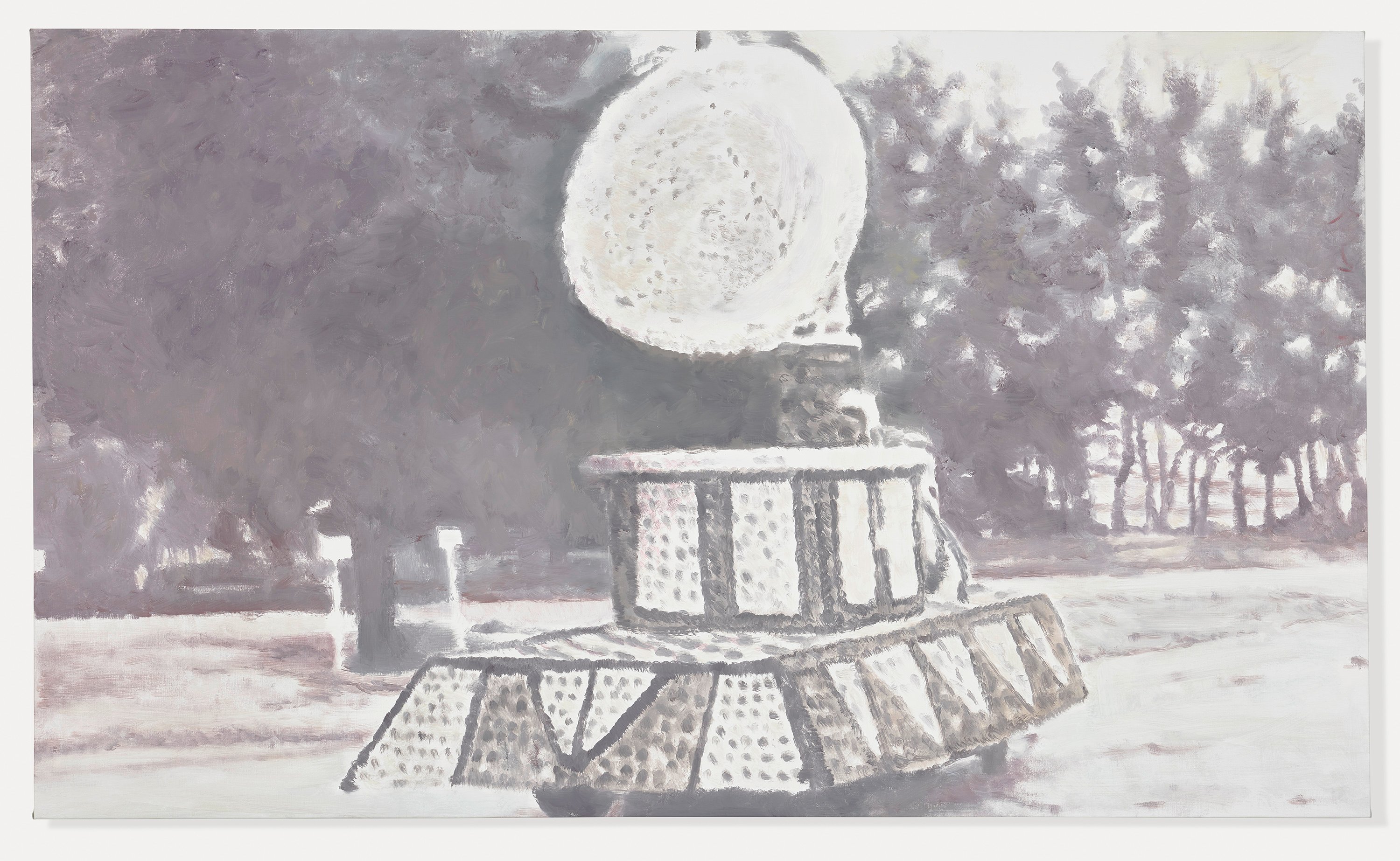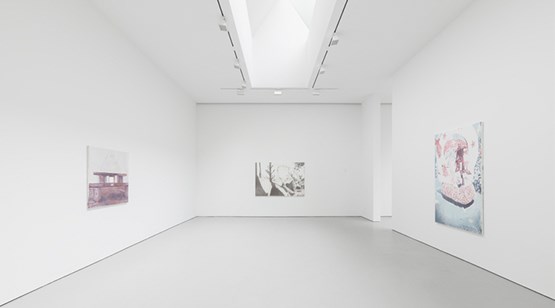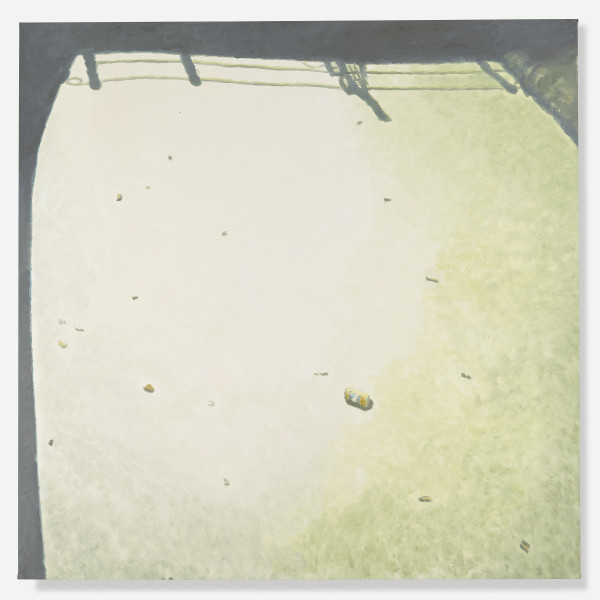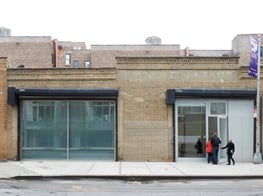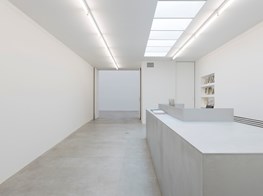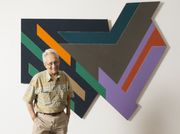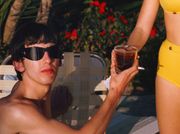Luc Tuymans
Luc Tuymans. Courtesy David Zwirner, New York/London. © Photo by Philippe De Gobert.
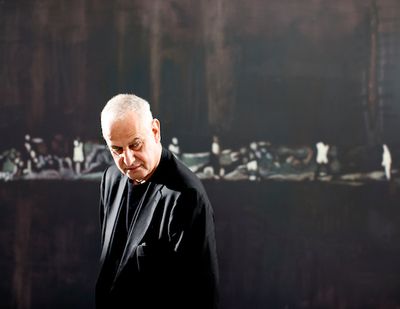
Luc Tuymans. Courtesy David Zwirner, New York/London. © Photo by Philippe De Gobert.
With over 120 solo shows, and 600 group shows on his curriculum vitae, Luc Tuymans is credited by critics such as Peter Schjeldahl with having contributed to the revival of painting, which misguided critics have been eulogising since 1839, when the French painter Paul Delaroche declared it dead.
After studying art history at Vrije Universiteit Amsterdam, and working as a bouncer in Brussels, Tuymans became a full-time painter in the early 1990s. In 1994, he was one of the first artists picked up by the burgeoning David Zwirner gallery—both the gallery and the artist have since become international art world phenomena.
Tuymans' paintings are marked by quiet, restrained tones which seem to suggest they come from a place beyond reality. Tackling weighty themes such as the Holocaust, 9/11, the colonial history of his native Belgium, and market capitalism, Tuymans paints from photographs culled from newspapers, magazines, and his personal archive. As a result, they exist somewhere between the real and the copy: they are memories from secondary sources, bearing witness to retelling.
For his exhibition Le Mépris (5 May–25 June), at David Zwirner in New York, Tuymans approached the general theme of 'contempt' with two series of paintings. The first depicts the Zundert Flower Parade, a yearly event in the afore named Dutch town where his mother was born. It consists of works such as Corso II (2015), which is based on a photograph Tuyman's father took of a float in the parade in 1958, the year the artist was born, and which is rendered in pale shades of primary colors. The second series features the polluted waters of the canals of Ridderkerk, a town in the western Netherlands. The colours are more sub fusc here: including jaundiced greens and yellows in works like Murky Water I (2015), used to depict garbage floating on the surface of the canals.
In this Ocula Conversation, Tuymans discusses his latest show, his process, politics, sense of ennui and feelings on the current state of the art world.
BWWhere does the title of the show, Le Mépris, come from?
LTThe title of the show, Le Mépris, is loosely and literally translated as 'contempt', which is how I feel. One painting that really goes with the title is the very last painting in the show [Le Mépris (2015)], and it is also the last that I painted for the show. It depicts the interior of a very famous villa on Capri, which was built for the Italian writer [Curzio] Malaparte. On that rooftop, Jean-Luc Godard shot a fabulous film called Le Mépris with Michel Piccoli and Brigitte Bardot, where you can really see that Brigitte understands zilch of the dialogue. It's a film that escapes Jean-Luc Godard in a very odd way. It's also the very last film image of Fritz Lang, so it's an epic thing where everything comes together. The film is one in a million, actually.
The idea for the show came about with the very first paintings, which show wagons stitched with flowers. [Tuymans is referencing works from the 'Corso' series, which depict images of the Zundert Flower Parade.] The ones in colour are based on images that my father photographed, and the ones in black and white and sepia are based on archival images from my birth year in 1958. My monochromes are of Zundert, where they stage the parade on the first Sunday of every September. It's the same village in which Van Gogh was born.
Every painting takes one day, always. That doesn't mean that I paint every day—it's like one day a week. That means conceiving a show is really the hardest work, but it keeps the intentionality very highly strung, because it's planned and mentally prepared out to the point where I don't have to think. My intelligence goes through my hands only.
As a kid, I used to go there on holidays, and I worked on these floats. They were produced secretly six months ahead of time, and only on that particular Sunday, were they paraded out to the public. One of them was given a prize and the other ones were all stacked in an industrial square near the milk factory for a week after which they were demolished.
These wagons were quite close to the ground, so it meant that the kids had to run underneath and push. It was a little bit like slavery. For these works I picked out the wagons and took out all the people. I used the ones that are very singular in form, sort of flamboyant. They also have a very aggressive tension to them, emphasised by the fact that the wagons move so slowly. That one for example, Corso III (2015), is nearly propaganda; it could make you think of Russia.
So the exhibition developed from these paintings, in combination with Polaroids I took years ago for a different project. I decided to make fairly large paintings of the Polaroid images, which are about the element of decay. So this [points to Murky Water I] was the very first one in that group. Actually, the first idea for the show was to do all the paintings about murky water. But in the process, I came back to this idea of combining the two series, and so I made them in conjunction.
See the little can floating on this murky, very filthy water [points to a detail of Murky Water I]? The idea of this mépris, but also of decay ... it is also in the flowers in a festive way, but they will decay, too.
In each painting, there is no real physical or tangible presence of a person. There are no people. This gives an element of imminent premonition of a public event and its aftermath.
BWDid you paint them all around the same time?
LTWhat happens mostly when I work is that for months I prepare with drawings, pictures, even maquettes. And then when all the pictures are together, one after the other, I will paint them. Every painting takes one day, always. That doesn't mean that I paint every day—it's like one day a week. That means conceiving a show is really the hardest work, but it keeps the intentionality very highly strung, because it's planned and mentally prepared out to the point where I don't have to think. My intelligence goes through my hands only. Then it goes through a very speedy process which is very attentive and very concentrated. That's how the imagery comes out.
BWWhat do you feel contempt about?
LTEverything. Politics for sure. You could say we're living in interesting times. A bit worse than that. But we're also living in the decline of the West. So this show talks about the premonition of decay.
In the painting Le Mépris, there is a window of the Capri villa that looks out to the sea. You don't see the villa's exterior, because I didn't want to show the splendour of this building, which is a beautiful landmark, of course—iconic as a symbol of European architecture. But the painting shows just the inside, and the light sort of meekly beams out.
BWDo you think these paintings will speak differently to an American audience than they will to a European one?
LTI think this [exhibition] will show the work very nicely. I think most of it will come across as very abstract. Knowing how hysterical Americans can get, I think they will love it.
I have a great fascination with artists like Ad Reinhardt and Rothko, especially with Rothko's 'Seagram' series of paintings—not that the paintings in the show resonate as such, but there is an element of similarity in their size and the fact that they are square.
[Points to Murky Water I.] It's only in the third image that you can sort of perceive what you're actually looking at, because you see a part of the border that indicates that these are shadows and that there's a foreground and something sticking out. So that is important. And they're all about passivity, in a way, about floating.
So there is a bit of a perceptive challenge involved for the spectators, and that's funny. It was really strange when I got to the gallery, because I had planned the layout in a way that was totally different. When we got here, we had to change it around. In my studio, these paintings look half the size that they do here. And my studio's not as big as this space. That's a really weird sensation for me.
I also curate shows. And mostly on my own: I have done 14 of them, and quite major ones. That is a way to deal not only with other artists, but also with the content in a completely non-market-driven way.
BWIn this recent series, you are mining your personal history; going back and looking at photographs you've taken.
LTI started to do that six or seven years ago, during the financial crisis, when it was time—instead of being shell-shocked— to just organise yourself. So from then on, I took everything in my hands in terms of publications, in terms of the archive. I have probably the best digital archive on the globe. Over the past six or seven years, we have been preparing a catalogue raisonné of my paintings—there are going to be three or four volumes in total. It will also include the source materials for the works; we keep all the elements in the archive.
BWI want to go back to the idea of floating.
LTYou see an idea of floating time. In paintings, painted time is something different than real time. You could say there is an element of melancholy, of nostalgia, but it's kind of twisted in a way. There's an element of aggression. So, it's torture. For me, torture is only effective when it's really tender.
BWWhen it has an element of love to it?
LTYes, because then it's even more horrible. That is actually how the idea of water came up; the stupidity, the banality of the water in those paintings. But then there's an element of beauty, and at the same time it creates an element of angst.
BWAnd patriotism?
LTOne of the journalists that came to look at my studio recently is probably going to relate the paintings to the elections or something, which would be really insane. As I said, the void in this show is imminent.
BWTo go back to the theme of the show, do you have contempt for the art world or the system that these paintings exist within?
LTIn a sense, you can't feel contempt for the hand that feeds you. But there is an element of danger. When I first started working with David [Zwirner], he had four or five artists. Now he has a whole street. If I were a new artist, I'd be really afraid. That means that the gallery is going to brand you. And of course, I'm lucky to be a bit older. I'm well aware that it's very difficult to be a young artist now. A lot of things are monopolised. But still, the market remains the market. I'm not going to shit on it, because it's what I live off. Even so, I think it's necessary for the market also to diversify itself a little bit. If I see that my work is much more expensive than buying a sculpture that belongs to older art history, basically I have to admit that's a bit disproportionate, if I have to be honest.
I never gave the market any thought when I started out as an artist. Initially I was chucked out of every academy and I worked as a bouncer, up to the point that I became too restless and needed to show my art. It is actually also a war zone. That's how I treat it. I treat it [the market] as a war zone, basically.
But I mean, I never had the strategy of the young artists coming out of art schools today. Not only that, there are many more magazines and there is also an entire discourse around the art world, and with all the networking it actually protects itself. It doesn't necessarily criticise the art market or the mechanism in a constructive way. And when it comes to writing about art, the critical mass has diminished. The interesting people writing about art are getting old; they're 60 or 70 years old. These are things one should be aware of. I think most young artists are aware of them.
I was very happy to attend a dinner about two weeks ago organised by Tobias Rehberger, who curated a gigantic group show in Galerie neugerriemschneider in Berlin. He asked all the artists he knew over a period of years to participate in the exhibition. But the evening was not about the show; it was about the dinner. I sat next to Jean-Marc Bustamante, whom I had first and last seen in 1993. The second time was at that dinner. This illustrates how difficult it already is for the same generation just to come together—except in an airport, when this person is flying here or there. This, I think, has to change.
BWHow do you create the space and time to be able to think about your work?
LTWell, first of all, I also curate shows. And mostly on my own: I have done 14 of them, and quite major ones. That is a way to deal not only with other artists, but also with the content in a completely non-market-driven way.
The Belgian nature is one that is not romantic. It deals with the real and only the real, because we've been overwhelmed by so many foreign nations. Therefore, I've learned to be very individual, very opportunistic and fast. Belgium has only been a nation for a very short period of time, but the country has great prominence when it comes to Europe. It created the best painter of the Western hemisphere, who is not Leonardo da Vinci, but Jan van Eyck. We all know that. But it's all about the real. Even van Eyck, as a concept, is about realism. It's about what is there. And it's unforgettable. He had a motto, something like: 'Be hefty on the humility, but behind that, have the most gigantic ambitions, of course.' And that's how it functions. We're very good with stress, so it's fine.
BWSo you feel deeply Belgian?
LTI feel deeply Belgian because it's a lone nation. That's what is beautiful about it. Any sense of nationalism I think is horrible, especially in the cultural realm, because culture has never had boundaries. The diversity was already there.
BWDo you mostly work in your studio?
LTI make drawings on the plane, or anywhere; but painting I only do in the studio. I don't see any point in getting a stipend or moving to Berlin to paint. It's not necessary. It's a more interesting process for people who work in another way. As for painting, no. Just alone in the studio. It's very, very lonely. But it's good. No music, also. I've never bought a record in my life.
BWWhere did you work as a bouncer?
LTI worked in clubs, each with the capacity of 600 people, that I had to manage myself. Huge, gigantic discotheques with six bouncers at a time. I've still got eyes on my back. I've never been mugged in New York, except once. The second time it was with a banana. The guy said: 'It's a banana stick-up.' I just went and broke the banana and said, 'Fuck you.' And he said, 'Where are you from?' and I said, 'I'm from Europe.' —[O]



